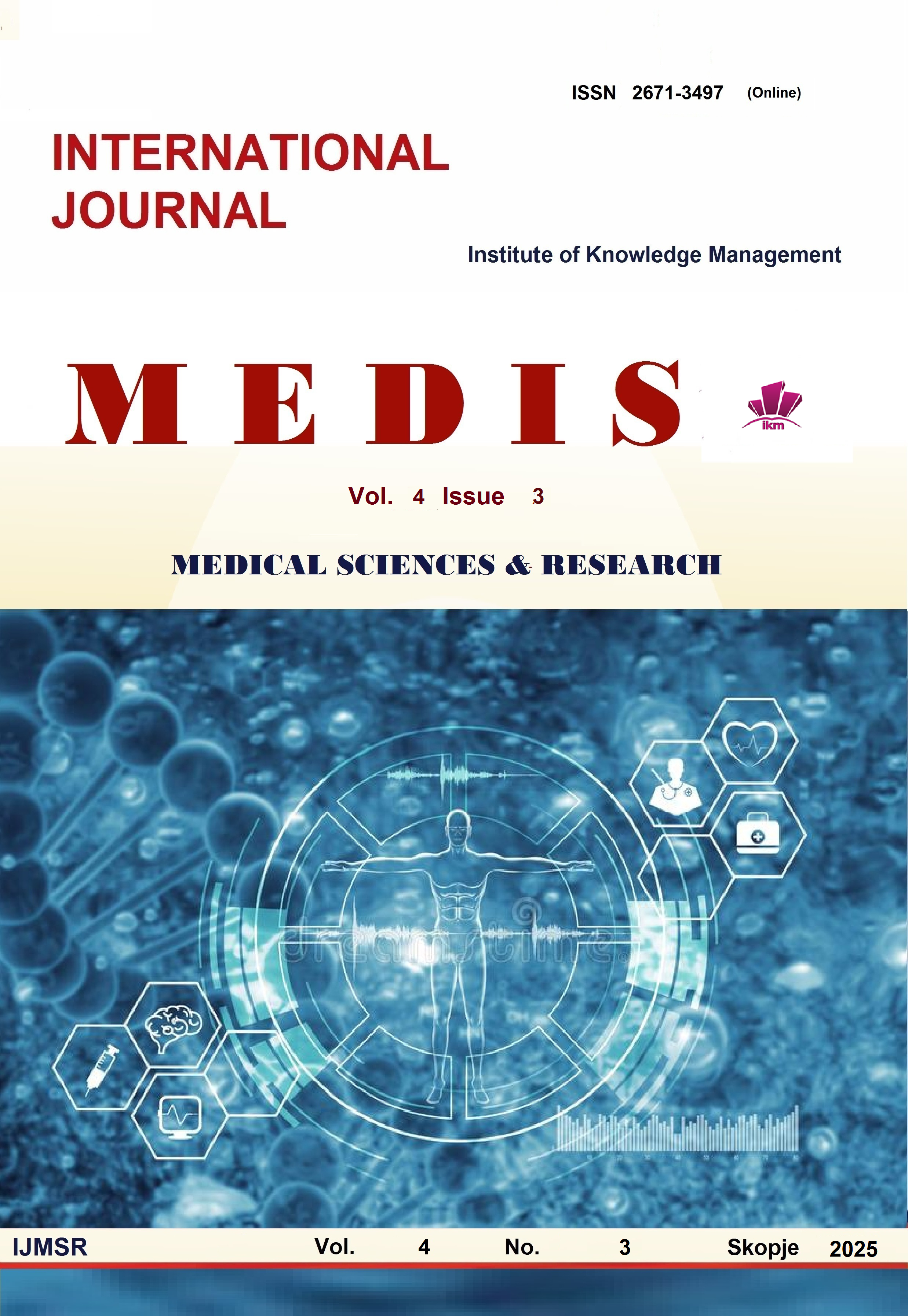PROVING THROMBOPHILIA IN SYMPTOMS OF HYPERSPLENISM
DOI:
https://doi.org/10.35120/medisij0403051tKeywords:
thrombophilia; hypersplenism; iron; ferritin; vit. B12.Abstract
Our interest in proving thrombophilia in symptoms of hypersplenism was sparked by a common and, at first glance, innocent clinical symptom - heaviness or pain in the left lower abdomen, in patients with anemia caused by iron deficiency or vitamin deficiency B12. We aimed to investigate some aspects of hypersplenism. Our task was to pay attention to how some, insignificant at first glance, clinical symptoms could hide the pathogenesis of tomophilias. For the realization of this task, we examined 130 patients, using their subjective complaints, supplemented them with abdominal ultrasound and laboratory blood analysis (PCK - WBC count; Er; Thr (thrombopenia; erythropenia; leukopenia;-pancytopenia), morphology of erythrocytes, morphology of platelets. Biochemistry - bilirubin - total and direct, iron, VLDL, VLDL, ferritin, vitаmin B12, etc. Coagulation - bleeding time). In the course of the study, we found that more than two-thirds of the patients with the diagnosed disease (97 people) complained of this type of heaviness or pain, which appeared very often after physical, and in some cases even after nervous- mental strain. Often, precisely these symptoms are the reason, if the patient comes to a competent doctor, to do the right tests, to make the correct diagnosis and to start adequate treatment. In the specific setting, we found that with adequate application of the substitution therapy and reaching the laboratory parameters characterizing the recovery, the pain and severity subside. Such symptoms, however, should always provoke the difficult and often very unpleasant diagnosis of thrombophilias in terms of differential diagnosis.
Downloads
References
Altwayan, R., Tombuloglu, H., Alhamid, G., Karagoz, A., Alshammari, T., Alsaeed, M., Al-Hariri, M., Rabaan, A., Unver, T. (2025). Comprehensive review of thrombophilia: pathophysiology, prevalence, risk factors, and molecular diagnosis. Transfusion Clinique et Biologique, 32, 2, 228-244.
Charrier, S., Blundell, M., Cédrone, G., Louache, F., Vainchenker, W., Thrasher, A. J., & Galy, A. (2013). Wiskott-Aldrich syndrome protein- deficient hematopoietic cells can be efficiently mobilized by granulocyte colony-stimulating factor. Haematologica, 98, 1300–1308.
Chu, H. C., Hsieh, C. B., Hsu, K. F., Fan, H. L, Hsieh, T. Y., & Chen, T. W. (2015). Simultaneous splenectomy during liver transplantation augments anti-viral therapy in patients infected with hepatitis C virus. American Journal of Surgery, 209, 180–186.
Djordjević, J., Svorcan, P., Vrinić, D., & Dapcević, B. (2010). Splenomegaly and thrombocytopenia in patients with liver cirrhosis. Vojnosanitetsci Pregled, 67,166–169.
Eubank, T. D., Galloway, M., Montague, C. M., Waldman, W. J., & Marsh C. B. (2003) M-CSF induces vascular endothelial growth factor production and angiogenic activity from human monocytes. Journal of Immunology, 171, 2637–2643.
Gregušová, A., Slováˇciková, M., Gazdíková, K., Dobrotová, M., Jezberová, M., Žigrai, M. (2025). Portal Vein Thrombosis in Second Trimester of Pregnancy. Journal of Clinical Medicine, 2025, 14, 1713.
Hostiuc, M., Negoi, I. (2025). Etiology and Risk Factors for Splanchnic Vein Thrombosis in Non-Cirrhotic, Non-Neoplastic Patients: A Narrative Review. Medicina, 61, 933, 1-23.
He, X. H., Li, W. T., Peng, W. J., Li, G. D., Wang, S. P., & Xu, L. C. (2011). Total embolization of the main splenic artery as a supplemental treatment modality for hypersplenism. World Journal of Gastroenterology, 17, 2953–2957.
Ismail, E., Abdelmoety, H., Elgerby, M. M., & Abden, H. (2012). Splenic irradiation in the treatment of hypersplenism from congestive splenomegaly. Life Science Journal, 9, 1121–1126.
Jiang, A., Zhang, S., Li, Z., Liang, R., Ren, S., Li, J., Pu, Y., & Yang J. (2011). miR-615-3p promotes the phagocytic capacity of splenic macrophages by targeting ligand-dependent nuclear receptor corepressor in cirrhosis-related portal hypertension. Experimental Biology and Medicine, 236, 672–680.
Kodama, T., Takehara, T., Hikita H, Shimizu S, Li W, Miyagi T, Hosui A, Tatsumi T, Ishida H, Tadokoro S, Tsubouchi, H., & Hayashi, N. (2010). Thrombocytopenia exacerbates cholestasis-induced liver fibrosis in mice. Gastroenterology,138, 2498.
Li, Z. F., Zhang, Y., Gao, J., Zhang, P. J., Wang, J. X., & Liu, X. G. (2004). Expression and significance of Toll-like receptor 4 of splenic macrophage in patients with hypersplenism due to portal hypertension. Zhonghua Yi Xue Za Zhi, 84 (3), 1088–1091.
Lv, Y., Han, X., Gong, X., Ma, Q., Chang, S., Wu, H., Li, Y., Deng, J. (2015). Grading of peripheral cytopenias caused by nonalcoholic cirrhotic portal hypertension and its clinical significance. Cell Biochemistry and Biophysics, 71, 1141–1145.
Lv, Y. (2014). Causes of peripheral blood cytopenias in patients with liver cirrhosis portal hypertension and clinical significances. Open Journal of Endocrine Metabolic Diseases, 4, 85–89.
Ma, J., Chen, T., Mandelin, J., Ceponis, A., Miller, N. E. Hukkanen, M., Ma, G. F., & Konttinen Y. T. (2003). Regulation of macrophage activation. Cellular and Molecular Life Science, 60, 2334–2346.
Premkumar, M., Bhujade, H., Sharma, P., Nain, J.; Ahluwalia, J., Sandhu, A., Kumar, Y., Rathi, S., Taneja, S., Duseja, A.K., Kulkarni, A., Singh 5, Shano, C., Naseem, Karki, T., Gupta, P., Chaluvashetty, S., Lad, D., K Rajender Reddy, K. R. (2025). Experience with Dabigatran on Rate of Portal Vein Thrombosis Recanalization, Disease Progression and Survival. Alimentary Pharmacology anf Therapeutics, 61, 971–987.
Sankararaman, S., Velayuthan, S., Vea, R., & Herbst, J. (2013). Severe gastric variceal bleeding successfully treated by emergency splenic artery embolization. Pediatrics, 55, e42–e45.
Shah, S. H., Hayes, P. C., Allan, P. L., Nicoll, J, & Finlayson, N. D. (1996). Measurement of spleen size and its relation to hypersplenism and portal hemodynamics in portal hypertension due to hepatic cirrhosis. American Journal of Gastroenterology, 91, 2580–2583.
Downloads
Published
Issue
Section
License

This work is licensed under a Creative Commons Attribution-NonCommercial 4.0 International License.






